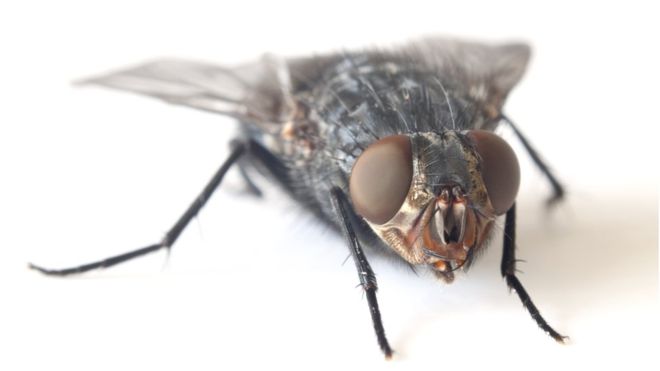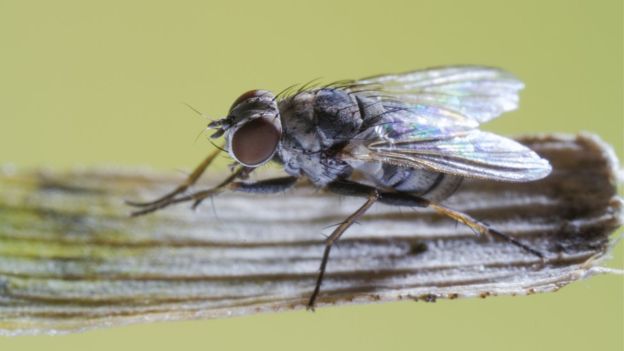Why is a fly so hard to swat?

Try to swat a fly, and soon you will see that it is faster than you. Much faster. But how do these tiny creatures with their smallest brains cheat us so easily?
You probably thought about this, after you ran after the fly around the house, waving sneakers, and unsuccessfully slamming it over and over again. How does she move so fast? Is she reading my mind?
')
This question was covered in the last episode of our BBC World Service CrowdScience program, which described the superpowers of small animals. The essence of the answer is that, compared with us, flies perceive our world in slow motion.
For illustration, pay attention to the clock with a second hand. A person sees the movement of the arrow with a certain speed. For a turtle, this speed is twice as much. For most species of flies, each ticking lasts about four times longer. The perceived speed of time is different for different species.
This happens because animals perceive the world around them as a continuous video. In fact, they build this picture on the basis of images coming from the eyes to the brain as separate flashes, a certain number of times per second. In humans, about 60 such flashes occur per second, in turtles - 15, in flies - 250.
Everything is relative
The speed at which these images are processed by the brain is called the “ flicker fusion rate ”. Usually, the smaller the view, the greater its fusion rate - and then the flies are far ahead of us.
Professor Roger Hardy from the University of Cambridge is studying the work of the fly's eyes, and he has an experiment to determine the speed of flicker fusion.

“The speed of flicker fusion is just a measure of how quickly you need to turn off and turn on the light so that it appears continuous,” says Professor Hardy.
Roger inserts tiny glass electrodes into living photosensitive eye cells — photoreceptors — and then uses LEDs that flash at an ever-increasing speed. Each flash of the LED causes a small electrical current in the photoreceptors, and it can be seen on the computer screen. Tests show that the fastest flies react to blinking up to 400 times per second — more than six times our speed.
The fastest vision of all was found in flies, which are literally called “killer flies” [to all appearances, we mean Coenosia attenuata , the so-called hunter fly originating from the south of Europe / approx. trans.]. These are small predatory flies living in Europe, catching other flies in the air, and possessing an ultrafast response. In the mushroom lab at the University of Cambridge, Dr. Paloma Gonzales-Bellido demonstrates the hunt for killer flies, releasing a special box for shooting victims in the form of fruit flies.
Paloma records their behavior at a speed of 1000 frames per second using a special camera. A computer connected to it records video, which is rewritten every 12 seconds. During the movement of the fly, Paloma presses the button if he wants the last 12 seconds of the video to be recorded for a long time.
“Our reaction time is so bad that if we wanted to stop the video, thinking that something was happening, it would have happened,” says Gonzales-Bellido. We do not even have time to press a button before everything happens - it’s so fast.
Fly vs fly
Once in the box with the victims, the killer fly first sat motionless, but as soon as the fruit fly flew 7 cm from it, it made a sharp movement, and suddenly the killer fly found itself at the bottom of the box, chewing on the trembling sight.
Only when watching a slow-motion video on a computer, it became clear what happened: the killer fly took off, flew around the fruit fly around three times, constantly trying to grab it, and then it still managed to grab it by its front paws.
And the whole story took only one second. The eyes perceive it as a flicker, so the clapping hand of a man for a fly must move at a snail's pace.


So that the killer fly could move so fast, even ahead of other flies, the light-sensitive cells in its eyes contain much more mitochondria (“batteries” of biological cells) than other flies.
These are batteries that power the cell, so quick vision should take more energy than slow ones. This explains why the eyes are simply not set to the fastest mode possible.
The carnivorous diet of killer flies gives them a lot of energy needed to power high-energy cells. But even if there were as many mitochondria in the cells of our eyes, we would not have such a high-speed vision, since the photosensitive cells of the flies are arranged quite differently, not like in vertebrates.
The reason for the structural differences in the structure of the eye is evolution. In arthropods and vertebrates, groups for flies and humans, respectively, the evolution of the eyes was separate the last 700-750 million years.
String theory
The eyes of the flies evolved to perceive light through a set of tiny string-like structures arranged horizontally along the path of light in the eye. These structures react mechanically to light, while vertebrates have elongated cells that look like tubes directed towards the light, in which chemical compounds react to light.
Roger, in his laboratory, studies the structure of the fly's eye. "It is more sensitive, in the sense that it is capable of producing a large signal for the smallest amount of light, and it can also react faster than the rods and cones in the eye of vertebrates," he explains.

There are several reasons for this increased sensitivity, but it is Hardy who discovered that they react to light mechanically, and not chemically, like cones and rods.
Mechanical response allows you to quickly create nerve signals. In addition, there is a limit to the speed with which nerve impulses can go — and the short distance between the eye and the fly’s brain speeds up the process compared to large vertebrates.
Some vertebrates have faster sight than ours. Apparently, the ability to fly correlates with the speed of view, as well as small size. Perhaps this is due to the fact that small flying animals must be able to react quickly in flight in order to avoid approaching obstacles.
Slow popping
The fastest vision is found in species that catch flies in the air.
Investigating the sight of the pied flycatcher , a small bird of a passerine group that flies on the fly, scientists from the University of Uppsala in Sweden found that it can distinguish blinking light at a speed of 146 times per second.
The birds were trained to link the flashing light to the treat, and they successfully distinguished the flashing light to speeds of 146 times / s. This is about two times faster than humans can see, but not as fast as the average fly. This means that birds, like flies, perceive every ticking of a clock more slowly than people.
The flycatcher is under pressure from evolution, forcing him to perceive the passage of time as slowly as possible in order to get ahead of their quick prey. In the course of evolution, birds that perceive time more slowly can react to prey faster, eat more, grow more chicks and pass on high-speed vision to future generations.
Flies, which are caught by birds with quick eyesight, will also produce an accelerating reaction to avoid being caught. This evolutionary arms race goes more than the birds themselves exist. Former prey flies have developed quick sight to avoid catching predatory flies since they learned to fly.
The next time you unsuccessfully try to swat a fly, do not be discouraged. Your awkward and slow motion met with millions of years of natural selection, which allowed the flies to perceive your attempts in slow motion. In general, for you and for the fly, time, apparently, is relative.
Source: https://habr.com/ru/post/373859/
All Articles